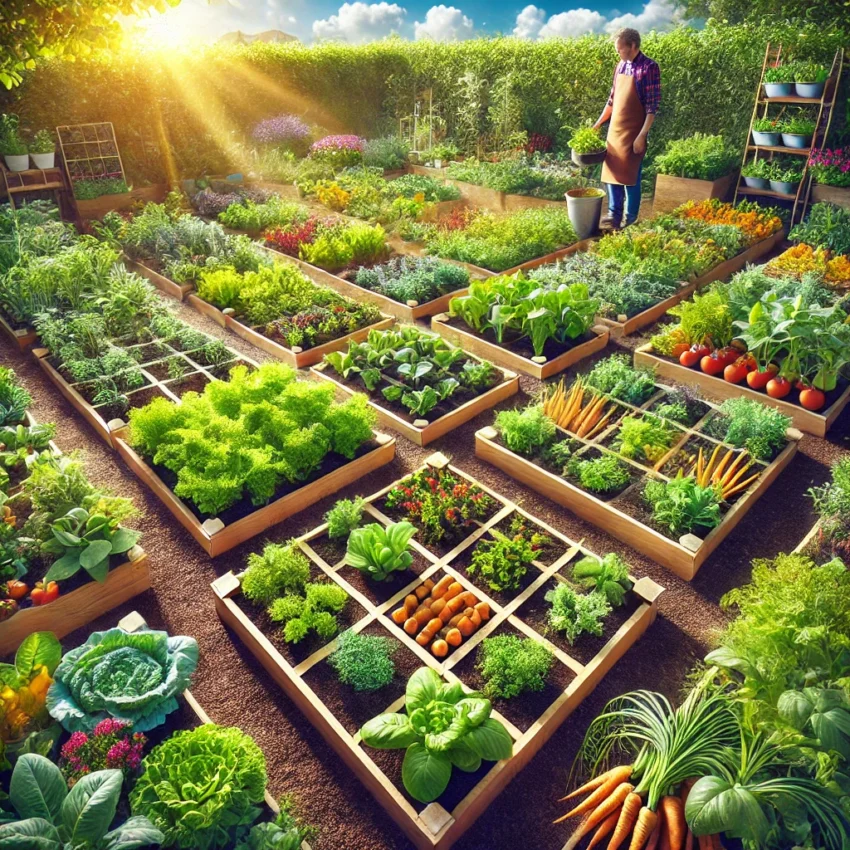What is Square Foot Gardening?
Square foot gardening is an efficient and space-saving method of growing vegetables, herbs, and flowers. Developed by Mel Bartholomew in the 1980s, this technique divides a raised garden bed into small, manageable sections, usually one square foot each. The goal is to maximize yield in a limited space while minimizing waste, effort, and maintenance.
Why Choose Square Foot Gardening?
If you’ve ever struggled with traditional row gardening, you’re not alone. Square foot gardening offers a smarter, more organized way to grow plants with less effort. It’s perfect for beginners, urban gardeners, and those looking to get the most out of a small space. Here’s why this method stands out:
- Space Efficiency – Grow more in less space by organizing plants in grids.
- Less Weeding – Densely packed plants reduce weed growth.
- Water Conservation – Small, contained areas require less watering.
- Easy Maintenance – No need for heavy tilling or excessive fertilization.
- Higher Yields – Optimized spacing leads to healthier plants and better productivity.
How to Set Up a Square Foot Garden
Setting up a square foot garden is simpler than you might think. Here’s a step-by-step guide:
1. Choose the Right Location
Pick a spot that gets at least 6-8 hours of direct sunlight per day. Ensure the area has good drainage and is easily accessible for watering and maintenance.
2. Build a Raised Bed
A standard square foot garden is 4×4 feet, divided into 16 one-foot squares. Use untreated wood, bricks, or other non-toxic materials to build the frame. Keep the bed 6-12 inches deep to accommodate root growth.
3. Prepare the Soil Mix
The secret to a thriving square foot garden is Mel’s Mix, a blend of:
- 1/3 compost (nutrients)
- 1/3 peat moss (moisture retention)
- 1/3 vermiculite (aeration and drainage)
This lightweight, nutrient-rich soil eliminates the need for heavy fertilization.
4. Create the Grid
Use wooden slats, string, or bamboo to divide the bed into 1×1 foot sections. This helps maintain plant organization and proper spacing.
5. Choose the Right Plants
Select crops based on your climate, space, and personal preferences. Here’s a quick guide:
- 1 plant per square – Tomatoes, peppers, broccoli
- 4 plants per square – Lettuce, spinach, Swiss chard
- 9 plants per square – Beets, onions, bush beans
- 16 plants per square – Carrots, radishes, scallions
6. Plant and Maintain
Follow seed spacing recommendations for each crop. Water regularly, mulch to retain moisture, and keep an eye out for pests. The beauty of square foot gardening is that you can harvest and replant continuously throughout the growing season.
Best Plants for Square Foot Gardening
Some plants thrive in this method better than others. Consider these top choices:
- Leafy Greens – Spinach, kale, lettuce (quick to grow and harvest)
- Root Vegetables – Carrots, radishes, beets (compact and efficient)
- Herbs – Basil, parsley, cilantro (small footprint, high yield)
- Compact Fruits – Strawberries, bush beans, peppers (productive and manageable)
Avoid plants that sprawl excessively, like pumpkins or melons, unless using vertical supports.
Common Mistakes and How to Avoid Them
Even with its simplicity, square foot gardening has some pitfalls. Here are common mistakes and how to fix them:
- Overcrowding Plants – Stick to the recommended number per square to avoid stunted growth.
- Neglecting Soil Health – Refresh compost each season to maintain nutrients.
- Ignoring Pests – Use companion planting and natural deterrents to prevent infestations.
- Inconsistent Watering – Square foot gardens dry out faster; ensure consistent moisture.
Conclusion
Square foot gardening is a game-changer for anyone looking to grow fresh produce in a small space. Whether you’re a beginner or an experienced gardener, this method simplifies gardening while maximizing yields. By following the proper setup and maintenance techniques, you can enjoy a thriving, productive garden all season long. Ready to start? Grab some wood, mix your soil, and start planting!
